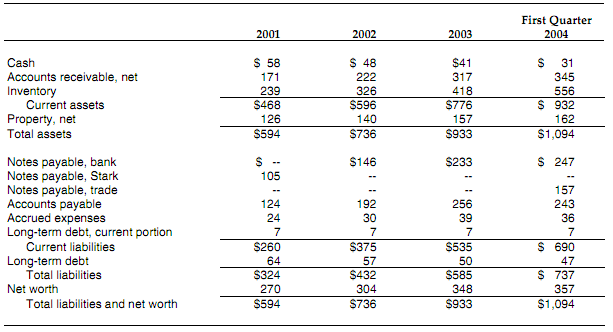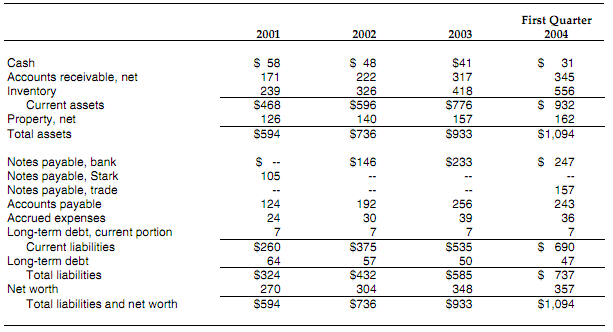Reference no: EM131200
Cartwright Lumber Company
After a rapid growth in its business during recent years, the Cartwright Lumber Company in the spring of 2004 anticipated a further substantial increase in sales. Despite good profits, the company had experienced a shortage of cash and had found it necessary to increase its borrowing from Suburban National Bank to $247,000 in the spring of 2004. The maximum loan that Suburban National would make to any one borrower was $250,000, and Cartwright had been able to stay within this limit only be relying very heavily on trade credit. In addition, Suburban was now asking that Cartwright secure the loan with its real property. Mark Cartwright, sole owner and president of the Cartwright Lumber Company, was therefore looking elsewhere for a new banking relationship where he would be able to negotiate a larger and unsecured loan.
Cartwright had recently been introduced by a friend to George Dodge, an officer of a much larger bank, Northrop National Bank. The two men had tentatively discussed the possibility that Northrop Bank might extend a line of credit to Cartwright Lumber up to a maximum amount of $465,000.
Cartwright thought that a loan of this size would more than meet his foreseeable needs, but he was eager for the flexibility that a line of credit of this size would provide. After this discussion, Dodge had arranged for the credit department of Northrop National Bank to investigate Mark Cartwright and his company.
The Cartwright Lumber Company had been founded in 1994 as a partnership by Mark Cartwright and his brother-in-law Henry Stark. In 2001 Cartwright bought out Stark's interest for $105,000 and incorporated the business. Stark had taken a note for $105,000, to be paid off in 2002, to give Cartwright time to arrange for the financing necessary to make the payment of $105,000 to him. The major portion of the funds needed for this payment was raised by a loan of $70,000 negotiated in late 2001. This loan was secured by land and buildings, carried an interest rate of 11%, and was repayable in quarterly installments at the rate of $7,000 a year over the next 10 years.
The business was located in a growing suburb of a large city in the Pacific Northwest. The company owned land with access to a railroad siding, and two large storage buildings had been erected on this land. The company's operations were limited to the retail distribution of lumber products in the local area. Typical products included plywood, moldings, and sash and door products. Quantity discounts and credit terms of net 30 days on open account were usually offered to customers.
Sales volume had been built up largely on the basis of successful price competition, made possible by careful control of operating expenses and by quantity purchases of materials at substantial discounts. Much of the moldings and sash and door products, which constituted significant items of sales, were used for repair work. About 55% of total sales were made in the six months from April through September. No sales representatives were employed, orders being taken exclusively over the telephone. Annual sales of $1,697,000 in 2001, $2,013,000 in 2002, and $2,694,000 in 2003 yielded after-tax profits of $31,000 in 2001, $34,000 in 2002, and $44,000 in 2003.
1 (Operating statements for the years 2001-2003 and for the three months ending March 31, 2004, are given in Exhibit 1.)
Mark Cartwright was an energetic man, 39 years of age, who worked long hours on the job. He was helped by an assistant who, in the words of the investigator for Northrop National Bank, "has been doing and can do about everything that Cartwright does in the organization." Other employees numbered 10 in early 2004, five of whom worked in the yard and drove trucks and five of whom assisted in the office and in sales.
As part of its customary investigation of prospective borrowers, Northrop National Bank sent inquiries concerning Mark Cartwright to a number of firms that had business dealings with him. The manager of one of his large suppliers, the Barker Company, wrote in answer:
The conservative operation of his business appeals to us. He has not wasted his money in disproportionate plant investment. His operating expenses are as low as they could possibly be. He has personal control over every feature of his business and he possesses sound judgment and a willingness to work harder than anyone I have ever known. This, with a good personality, gives him a good turnover; and from my personal experience in watching him work, I know that he keeps close check on his own credits.
In addition to owning the lumber business, which was his major source of income, Cartwright held jointly with his wife an equity in their home. The house had cost $130,000 to build in 1992 and was mortgaged for $90,000. He also held a $100,000 life insurance policy, payable to his wife. She owned independently a half interest in a house worth about $80,000. Otherwise, they had no sizable personal investments.
The bank gave particular attention to the debt position and current ratio of the business. It noted the ready market for the company's products at all times and the fact that sales prospects were favorable. The bank's investigator reported: "Sales are expected to reach $3.6 million in 2004 and may exceed this level if prices of lumber should rise substantially in the near future." On the other hand, it was recognized that a general economic downturn might slow down the rate of increase in sales.
Cartwright Lumber's sales, however, were protected to some degree from fluctuations in new housing construction because of the relatively high proportion of its repair business. Projections beyond 2004 were difficult to make, but the prospects appeared good for a continued growth in the volume of Cartwright Lumber's business over the foreseeable future.
The bank also noted the rapid increase in Cartwright Lumber's accounts and notes payable in the recent past, especially in the spring of 2004. The usual terms of purchase in the trade provided for a discount of 2% for payments made within 10 days of the invoice date. Accounts were due in 30 days at the invoice price, but suppliers ordinarily did not object if payments lagged somewhat behind the due date. During the last two years, Cartwright had taken very few purchase discounts because of the shortage of funds arising from his purchase of Stark's interest in the business and the additional investments in working capital associated with the company's increasing sales volume. Trade credit
was seriously extended in the spring of 2004 as Cartwright strove to hold his bank borrowing within the $250,000 ceiling imposed by Suburban National Bank. (Balance sheets at December 31, 2001-2003, and March 31, 2004, are presented in Exhibit 2.)
The tentative discussions between George Dodge and Mark Cartwright had been about a revolving secured 90-day note not to exceed $465,000. The specific details of the loan had not been worked out, but Dodge had explained that the agreement would involve the standard covenants applying to such a loan. He cited as illustrative provisions the requirement that restrictions on additional borrowing would be imposed, that the net working capital would have to be maintained at an agreed-upon level, that additional investments in fixed assets could be made only with the prior approval of the bank, and that limitations would be placed on withdrawals of funds from the business by Cartwright. Interest would be set on a floating-rate basis. Dodge indicated that the initial rate to be paid would be about 10.5% under conditions in effect in early 2004. Both men also understood that Cartwright would sever his relationship with Suburban National Bank if he entered into a loan agreement with Northrop National Bank.


Question 1: The short-form forecasting model (Q1 tab) shows 2003 as the base year (historical) and five forecast years, 2004-08. The forecast assumptions are entered for you in C4.G15. Show your understanding of the short-form forecasting model by answering the questions in the Q1 boxes.
Then, as the banker, explain to Mr. Cartwright why he must reduce his sales growth rate to reduce
2 Study the table on p 45 of the Cohen finance book and explanations on the pages following.
his external financing needs, supported by a revised forecast.
The Q2 tab includes a working (with the formulas) version of the p 45 table and the short-form forecasting model with zeros in the assumption cells C4,G15, so you can forecast a scenario more to the banker's
Download:- UNABRIDGED Wk2 Assignment Template 13jul-sum13.xlsx